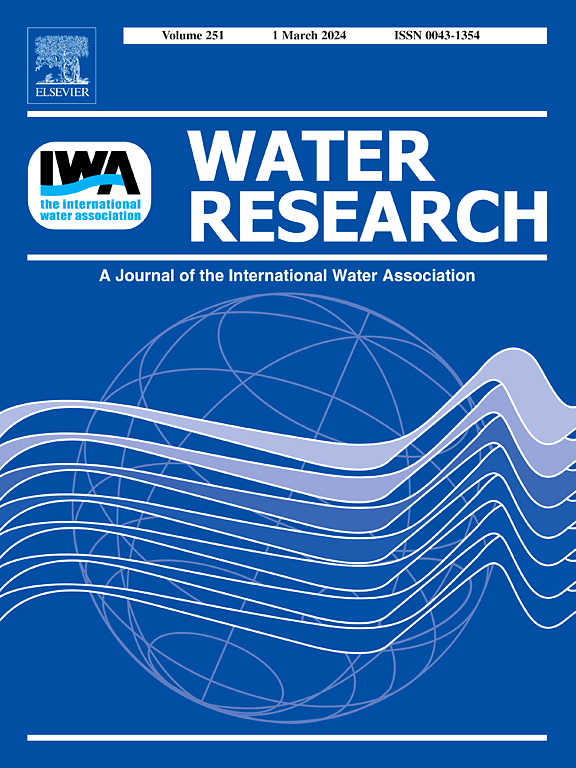微塑料对人工湿地去除阿特拉津的影响:微生物、酶活性和功能基因的响应特征
IF 11.4
1区 环境科学与生态学
Q1 ENGINEERING, ENVIRONMENTAL
引用次数: 0
摘要
人工湿地技术在农业面源污染治理中得到了广泛应用。然而,关于微塑料(MPs)对农药处理的影响机制和分布特征的认识有限。本研究以具有代表性的农药阿特拉津(ATZ)为模型污染物,系统研究了聚乙烯微塑料(PE MPs)对垂直潜流连续水体中ATZ和营养物质去除、酶活性和功能基因分布的影响。结果表明,与对照组(CK)相比,不同浓度MPs处理的CWs对ATZ的去除效果无显著差异。在第二阶段(ATZ=400 μg/L),含MPs的CWs对ATZ的平均去除效率略高于CK组。PE MPs使CWs的脱氮效率降低了1.57% ~ 3.03%,但对TP的去除效果不显著。基质层中PE MPs的浓度分布自上而下呈下降趋势,CWs的截留能力随时间逐渐降低(从100%下降到97.4%);暴露于PE MPs时,底物中与氮代谢相关的酶活性受到抑制;此外,CWs中添加PE MPs通过增加ATZ代谢菌(Hydrogenophaga、Zoogloea、Rhizobium等)和ATZ降解关键基因(atzA和trzN)的丰度,促进了ATZ的去除。这些结果不仅为化粪池在农药废水处理中的实际应用提供了理论支持,也为农药非点源污染生态处理技术在MPs存在下的环境风险控制提供了理论依据。本文章由计算机程序翻译,如有差异,请以英文原文为准。

Effects of microplastics on atrazine removal in constructed wetlands: Insight into the response characteristics of microorganisms, enzyme activity, and functional genes
Constructed wetlands (CWs) technology has been widely used to treat agricultural non-point source pollution. However, knowledge about the impact mechanism and distribution characteristics of microplastics (MPs) on pesticide treatment in CWs is limited. This study employed atrazine (ATZ), a representative pesticide, as a model contaminant, to systematically investigate the impacts of polyethylene microplastics (PE MPs) on the removal of ATZ and nutrients, as well as the enzyme activity and the distribution of functional genes in vertical subsurface-flow CW microcosm. The results showed that compared to the control group (CK), CWs treated with different concentrations of MPs had no significant difference in the removal of ATZ. Moreover, in the second stage (ATZ=400 μg/L), the average removal efficiency of ATZ by CWs containing MPs was slightly higher than that of the CK group. PE MPs reduced the nitrogen removal efficiency of CWs by 1.57%-3.03%, but had no significant effect on TP removal. The concentration distribution of PE MPs in the substrate layer exhibited a decreasing trend from top to bottom, and the interception capacity of CWs gradually decreased with time (from 100% to 97.4%); When exposed to PE MPs, the activities of enzymes in substrate related to nitrogen metabolism were inhibited; Moreover, the addition of PE MPs in CWs promoted the removal of ATZ by increasing the abundance of ATZ metabolizing bacteria (Hydrogenophaga, Zoogloea, Rhizobium, etc.) and ATZ degradation key genes (atzA and trzN). These results not only provide theoretical support for the practical application of CWs in the treatment of pesticide wastewater, but also provide a theoretical basis for the environmental risk control of pesticide non-point source pollution ecological treatment technology in the presence of MPs.
求助全文
通过发布文献求助,成功后即可免费获取论文全文。
去求助
来源期刊

Water Research
环境科学-工程:环境
CiteScore
20.80
自引率
9.40%
发文量
1307
审稿时长
38 days
期刊介绍:
Water Research, along with its open access companion journal Water Research X, serves as a platform for publishing original research papers covering various aspects of the science and technology related to the anthropogenic water cycle, water quality, and its management worldwide. The audience targeted by the journal comprises biologists, chemical engineers, chemists, civil engineers, environmental engineers, limnologists, and microbiologists. The scope of the journal include:
•Treatment processes for water and wastewaters (municipal, agricultural, industrial, and on-site treatment), including resource recovery and residuals management;
•Urban hydrology including sewer systems, stormwater management, and green infrastructure;
•Drinking water treatment and distribution;
•Potable and non-potable water reuse;
•Sanitation, public health, and risk assessment;
•Anaerobic digestion, solid and hazardous waste management, including source characterization and the effects and control of leachates and gaseous emissions;
•Contaminants (chemical, microbial, anthropogenic particles such as nanoparticles or microplastics) and related water quality sensing, monitoring, fate, and assessment;
•Anthropogenic impacts on inland, tidal, coastal and urban waters, focusing on surface and ground waters, and point and non-point sources of pollution;
•Environmental restoration, linked to surface water, groundwater and groundwater remediation;
•Analysis of the interfaces between sediments and water, and between water and atmosphere, focusing specifically on anthropogenic impacts;
•Mathematical modelling, systems analysis, machine learning, and beneficial use of big data related to the anthropogenic water cycle;
•Socio-economic, policy, and regulations studies.
 求助内容:
求助内容: 应助结果提醒方式:
应助结果提醒方式:


